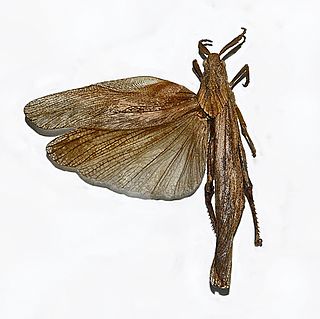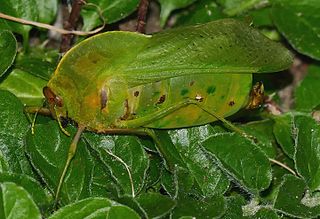
The Acrididae are the predominant family of grasshoppers, comprising some 10,000 of the 11,000 species of the entire suborder Caelifera. The Acrididae are best known because all locusts are of the Acrididae. The subfamily Oedipodinae is sometimes classified as a distinct family Oedipodidae in the superfamily Acridoidea. Acrididae grasshoppers are characterized by relatively short and stout antennae, and tympana on the side of the first abdominal segment.

Bandwings, or band-winged grasshoppers are the subfamily Oedipodinae of grasshoppers classified under the family Acrididae. They have a worldwide distribution and were originally elevated to full family status as the Oedipodidae. Many species primarily inhabit xeric weedy fields, and some are considered to be important locusts:

The grasshopper subfamily Acridinae, sometimes called silent slant-faced grasshoppers, belong of the large family Acrididae in the Orthoptera: Caelifera.

The Caelifera are a suborder of orthopteran insects. They include the grasshoppers and grasshopper-like insects, as well as other superfamilies classified with them: the ground-hoppers (Tetrigoidea) and pygmy mole crickets (Tridactyloidea). The latter should not be confused with the mole crickets (Gryllotalpidae), which belong to the other Orthopteran sub-order Ensifera.

The African rice grasshopper, Hieroglyphus daganensis is a medium-sized grasshopper species found in the Sahel region. Although not called a locust in English, this species shows gregarious behaviour and some morphological change on crowding and may become a moderately important pest species for small-holder farmers in the region.

Acrida is a genus of grasshoppers in the family Acrididae. The genus contains around 40 species which are found in Africa, Europe, Asia, North America, Hawaii, and Australia. Insects of this genus are omnivorous and a well-known pest of many agricultural crops.

Acridini is a tribe of insects in the subfamily Acridinae, of the insect family Acrididae and are sometimes called "silent slant-faced grasshoppers". It was firstly described as Truxalis Conicus in 1781

Phymateus aegrotus, sometimes called the blue bush locust or East African bush locust, is a pest species of grasshopper in the family Pyrgomorphidae. Unlike "locusts" the adults are not known to change their morphology on crowding, but at the hopper stage, marching behaviour of small bands may occur.

Anacridium moestum, the camouflaged tree locust, is a species of grasshopper belonging to the family Acrididae, that is native to Africa south of the equator. It is similar in appearance to the Southern African desert locust, Schistocerca gregaria subsp. flavicentris. It is likewise brownish, large and slender, but mostly arboreal in its habits.

Pamphagidae is a family of grasshoppers belonging to the superfamily Acridoidea. The species in this family can be found in Africa, Europe and Asia.

Xiphoceriana atrox is a species of grasshoppers belonging to the family Pamphagidae.

Acrididea including the Acridomorpha is an infraorder of insects that describe the grasshoppers and ground-hoppers. It contains a large majority of species in the suborder Caelifera and the taxon Acridomorpha may also be used, which excludes the Tetrigoidea. Both names are derived from older texts, such as Imms, which placed the "short-horned grasshoppers" and locusts at the family level (Acrididae). The study of grasshopper species is called acridology.

Calephorus compressicornis is a species of grasshopper in the tribe Calephorini found in Europe and Africa.

The Pneumoridae are a family of nocturnal short-horned grasshoppers in the order Orthoptera, commonly known as the bladder grasshoppers and the sole representative of the superfamily Pneumoroidea. Their centre of diversity is in southern Africa, but one species occurs as far north as South Sudan. Most adult males acquire an inflated abdomen, a specialization for amplified sound production, which is likely its primary function. Most genera display striking sexual dimorphism, and several species exhibit a dual male phenotype.

The Trigonopterygoidea are an insect superfamily in the Orthoptera: Caelifera. Sometimes described as leaf grasshoppers, American species in the Xyronotidae have also been called razor-backed bush-hoppers.
Pamphagodidae is a small family of grasshoppers in the Orthoptera: suborder Caelifera. Species in this family can be found in southern Africa and Morocco.

The Lentulidae are a family of grasshoppers found in sub-Saharan Africa.

The Hemiacridinae are a subfamily of Acrididae in the Orthoptera: Caelifera. Species can be found in Africa, and Asia.

Phymateus karschi is a locust in the family Pyrgomorphidae.

Eyprepocnemis plorans, the lamenting grasshopper, is a species of insect in the family Acrididae. It is the type species of the genus Eyprepocnemis, and is found in Africa, parts of the Middle East, and southern Europe. It typically inhabits wetlands and other moist habitats.


















